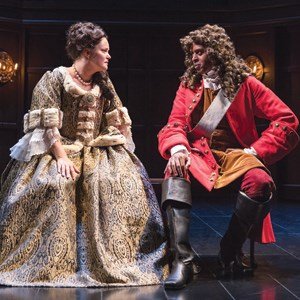A Royal for Rome? The last Stuart monarch's life unravelled
Mark Lawson - The Tablet - Sat, Aug 5th 2017
Queen Anne - Theatre Royal Haymarket, London
 Popular with modern dramatists is the game of imagining the royal history plays that Shakespeare never wrote. The subjects evaded him either because they would have been too dangerous – Howard Brenton’s Anne Boleyn – or due to the great chronicler of English monarchy being dead by the time the events occurred. In the latter category are Alan Bennett’s The Madness of George III, Mike Bartlett’s King Charles III and Helen Edmundson’s Queen Anne, premiered by the Royal Shakespeare Company two years ago and now revived in the London West End.
Popular with modern dramatists is the game of imagining the royal history plays that Shakespeare never wrote. The subjects evaded him either because they would have been too dangerous – Howard Brenton’s Anne Boleyn – or due to the great chronicler of English monarchy being dead by the time the events occurred. In the latter category are Alan Bennett’s The Madness of George III, Mike Bartlett’s King Charles III and Helen Edmundson’s Queen Anne, premiered by the Royal Shakespeare Company two years ago and now revived in the London West End.
Edmundson’s title character, Anne Stuart (1665-1714), the daughter of James II, had a life unusually shaped by faith. As a young woman, her Protestant piety was much advertised in order to appease those who feared that her father’s monarchy was sliding back towards Rome: he framed, in 1687, an extended version of Charles II’s Declaration of Indulgence, which promoted tolerance towards Catholics and Dissenters.
When these tensions contributed to the second James’ overthrow, Anne’s sister Mary claimed the throne alongside her Dutch husband, William III. Their infertility made Anne Queen, when in 1702, William died without heirs, but her own childlessness – she may have suffered as many as 17 miscarriages and stillbirths – left England existentially nervous and Scotland independently restless about what might follow.
France and Spain were contemplating a Catholic restoration by naval invasion. One character warns, in the enjoyably muscular language of Edmundson’s script, of the day “when British lungs are choked with incense once again”, and predicts that, by repelling this continental threat, they will “rid the world of papists and be thanked for ever after”.
The problem for these zealots was that, like Theresa May to the Conservative Brexiteers, Anne was less admired than seen as the only palatable figurehead for an anti-European cause. Shy, dumpy and suffering from a variety of ailments that include gruesomely depicted leg ulcers, Anne was a hard sell to the population even before the invention of television, and Emma Cunniffe, waddling and swaddled in padding, spares us nothing of Anne’s discomfort in her own body, while progressively exposing the bright and diligent mind within.
To the despair of anti-Catholic politicians, Anne may not have even reliably been a Protestant. One conspiracy theory was that she had always been a double-agent for her father and would return the throne to Rome. “Her High Church nonsense is only a step away from Popery!” a parliamentarian complains.
In political intrigue, gossip is a favoured bomb of plotters, and rumours about the Queen were explosive. Though married to the devoted but unworldly Prince George of Denmark, Anne became close to Abigail Hill, a maid, and, most durably, to Sarah Churchill, an aristocrat, for whom the Queen provided the land for what we know as Blenheim Palace. Historical fiction grants audiences the privilege of knowing the future and, in Queen Anne, we enjoy our awareness of the service that one of Sarah’s descendants will do to the crown when England is threatened with a mid twentieth-century invasion.
As written by Edmundson, Sarah Churchill is a monster of egotism and, in Romola Garai’s portrayal, has a terrifying physical and vocal command. Garai also suggests that, while Anne may have felt genuine passion for her friend, any romantic acquiescence from Sarah was more likely tactical career advancement.
Speculation about Anne’s true sexuality was sometimes seen as a reason for her failure to breed, an innuendo that prominent women do not escape today, although contemporary medicine might say that the Queen’s difficulties had more to do with the dynastic pressure in the royal family for close relatives to wed. However, the then rising industries of satire and caricature – led by Jonathan Swift and Daniel Defoe – seized on the Queen’s perceived secrets and physical indignities in skits, songs and pamphlets, versions of which punchily punctuate Natalie Abrahami’s production.
This savage early eighteenth-century commentary tempts us to make a connection with today’s social media eviscerations, and this is not the only contemporary resonance. In 2015 at Stratford, after the recent results of the Scottish independence referendum and the UK general election, audiences roared at the Queen’s admonition that “the Scots can not be trusted!” In the London revival, this gets an even larger laugh. In another tremendous scene, the Queen is told the country is bankrupt. Historians of modern Britain may also like to note that theatregoers in July 2017 responded with a kind of terrified delight to a line wondering “how much extra stress this country can endure before she is brought, convulsing, to her knees”.
A drawback of dramatising a little-known historical story is that the dialogue has to carry a huge amount of exposition. Several speeches cue up researched anecdotes. “Remember the night your father went out to meet William’s invading troops?” Sarah checks and, although the Queen does recall, tells her anyway. The same thing happens when Anne asks someone: “Do you remember when William and Mary first arrived?”
But Anne, a character who has been a victim of literature, now has cause to thank a writer who has restored her to attention in a powerful, intelligent and moving play.
share :


 Votes : 0
Votes : 0









